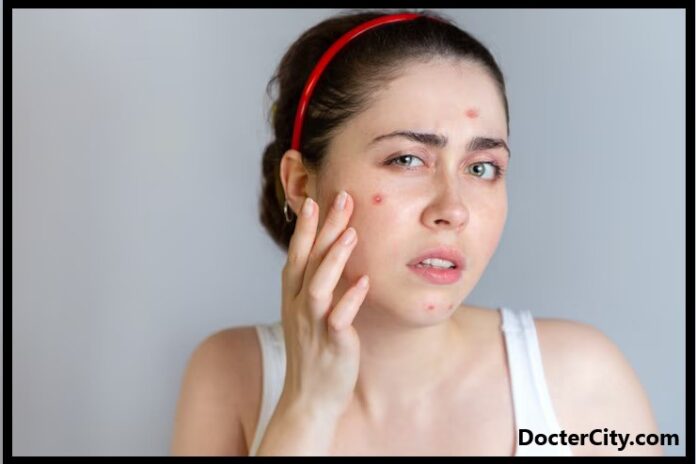Introduction
Bumps on forehead can cause concern, especially when they appear unexpectedly. Are these bumps indicative of acne, or could they signal an underlying issue? In this comprehensive guide, we will explore the various causes of spots on the forehead and examine whether they manifest acne or if something else is at play.
Understanding Acne on the Forehead
A common skin issue that may afflict anybody at any age is acne. Regarding the forehead, acne can manifest in different forms, including whiteheads, blackheads, papules, pustules, and cysts. The forehead is particularly prone to acne due to the high concentration of oil glands in this area. Excess oil, dead skin cells, and bacteria can clog the pores, leading to the development of acne.
Types of Acne on the Forehead
- Whiteheads and Blackheads: These are non-inflammatory types of acne that result from the clogging of pores with oil and dead skin cells.
- Papules and Pustules: These are inflammatory types characterized by redness and swelling. Spots are small, raised bumps, while pustules contain pus.
- Cysts: Deep, painful lumps beneath the skin’s surface indicate cystic acne. This severe form of acne can lead to scarring if not treated promptly.
Other Potential Reasons for Forehead Bumps
1. Contact Dermatitis:
Contact dermatitis can cause red, itchy bumps on forehead. These bumps result from an allergic reaction to a substance that comes into contact with the skin, such as certain skincare products, hair dyes, or environmental irritants.
2. Folliculitis:
Inflammation of the hair follicles, known as folliculitis, can lead to small red bumps on the forehead. Bacteria, yeast, or fungi can cause this condition.
3. Heat Rash:
In hot and humid conditions, sweat ducts can become blocked, leading to the development of heat rash. This can result in tiny bumps on forehead and other areas of the skin.
4. Rosacea:
Rosacea is a long-term skin disorder that results in visible blood vessels and redness.
Sometimes, it can lead to small, red bumps on the forehead resembling acne.
5. Stress and Hormonal Changes:
Stress and hormonal fluctuations can contribute to the development of forehead bumps. These changes may increase oil production, leading to acne breakouts.
Distinguishing Between Acne and Other Bumps
Given the various possible causes of bumps on forehead, it’s essential to distinguish between acne and other skin conditions. Here are some tips to help identify the nature of the bumps:
- Texture: Acne often presents with a specific texture – raised, with a central pore. Other conditions may have a different texture, such as the smooth, itchy bumps associated with contact dermatitis.
- Color: Acne lesions may appear red or have a white or blackhead at the center. Other conditions might present with a different color, such as the redness associated with rosacea.
- Pain and Itchiness: Acne can be painful, predominantly cystic acne, but it typically isn’t very itchy. Itchy bumps may be indicative of contact dermatitis or another allergic reaction.
Home Remedies and Treatment Options
1. Skincare Routine:
Maintaining a consistent and gentle skincare routine can help manage forehead bumps. Use a mild cleanser and non-comedogenic moisturizer to keep the skin clean and hydrated.
2. Topical Treatments:
Over-the-counter topical treatments containing benzoyl peroxide or salicylic acid can effectively treat mild acne. However, it’s crucial to patch-test any new products to avoid potential irritation.
3. Prescription Medications:
A dermatologist may prescribe topical or oral medications for more severe acne to address the issue. These may include retinoids, antibiotics, or oral contraceptives for hormonal acne.
4. Identifying Triggers:
Identifying and avoiding triggers is essential if bumps are related to contact dermatitis or another external factor. This may involve switching skincare products or being mindful of environmental exposures.
5. Professional Treatments:
A dermatologist may recommend in-office treatments such as chemical peels, microdermabrasion, or laser therapy to address persistent forehead bumps and acne scarring.
Conclusion
In conclusion, bumps on forehead can stem from various causes, and determining whether it’s acne or something else is crucial for effective treatment. A careful examination of the characteristics of the bumps, coupled with an understanding of potential triggers, can guide individuals toward the most appropriate treatment approach. Whether adopting a consistent skincare routine, topical treatments, or seeking professional help, addressing forehead bumps promptly can lead to more precise, healthier skin.
Remember, if you’re unsure about the nature of the bumps or if they persist despite home remedies, it’s always advisable to consult a dermatologist for personalized advice and treatment options.

